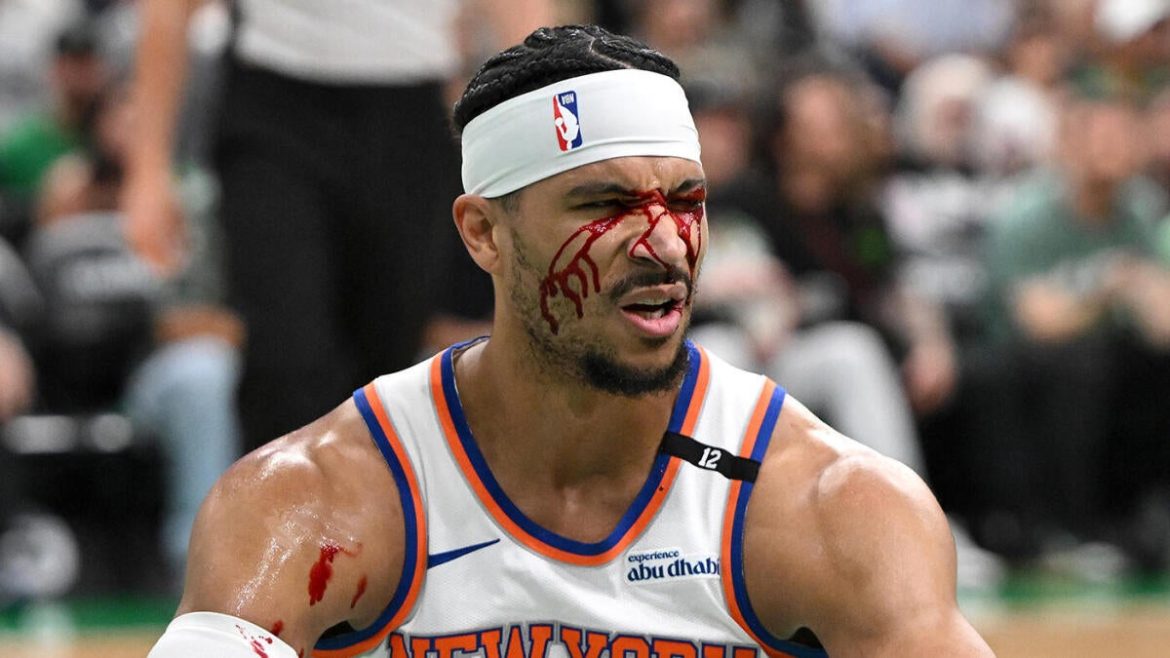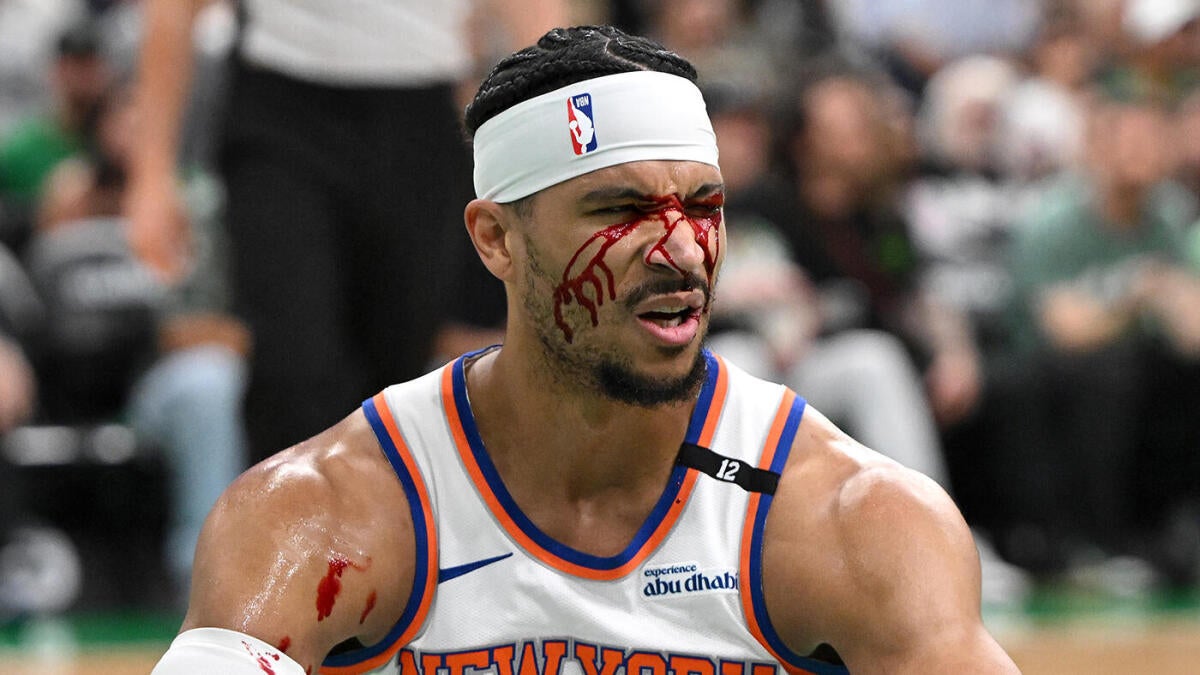In recent NBA playoff updates, one incident has captured significant attention due to its dramatic impact and visceral intensity: Knicks forward Josh Hart sustaining a facial injury after being struck by an elbow from Celtics big man Luke Kornet during Game 5 of the Eastern Conference semifinals. This moment not only exemplifies the physicality inherent in high-stakes basketball but also underscores how injuries—particularly visible ones—affect the narrative of crucial playoff games. Analyzing this event in detail reveals broader implications about player safety, game dynamics, and the emotional resilience required during intense postseason battles.
The Incident: A Closer Look at the Injury
The sequence unfolded early in the first quarter of the game, with Josh Hart driving toward the basket in a move emblematic of his aggressive playing style. As he elevates to prepare for a layup, Celtics center Luke Kornet slid over to defend the rim. In the process, Kornet’s elbow made inadvertent contact just above Hart’s left eye, resulting in a substantial cut that led to bleeding profusely. The images quickly circulated across social media, capturing a bloodied Hart wiping blood from his face amid the chaos of the game.
Multiple sources describe the injury as not only a superficial cut but a significant laceration that required players and officials to stop play temporarily. Hart fell to the ground immediately after contact, and the blood seeped out rapidly, saturating his face and the surrounding skin. Despite the severity, Hart was able to wipe off the blood, regain composure, and continue playing—exemplifying his toughness and mental resilience amidst adversity.
The Context and Broader Significance
Physicality and Incidental Contact
The incidental nature of the strike adds a layer of complexity to understanding the injury. Although the elbow was unintended and deemed a common foul, the visibility of the blood and the injury’s impact elevates the moment, highlighting how basketball’s physical contact, intentional or not, can have immediate consequences. The NBA emphasizes player safety, but inadvertent collisions remain part of the game’s intensity, especially during high-pressure playoff situations where players often push the boundaries of physicality.
Emotional and Psychological Impact
For Hart, the injury likely tested his mental toughness. Blood streaming down his face in a critical game, he visibly wiped blood away to shoot free throws, displaying unwavering focus. Such moments are emblematic of the grit often celebrated in playoff narratives—players willing to endure pain for the team’s success. This resilience tends to galvanize team morale and energize fans, serving as a symbol of determination amid adversity.
Impact on Game Momentum
While the injury drew attention, the game’s flow remained relatively unaffected structurally; play resumed after the stoppage, and Hart continued contributing. Such incidents test players’ resolve but also have potential psychological effects on both teams. The Celtics might have seen the injury as a moment of vulnerability, while the Knicks could rally around Hart’s display of endurance, bolstering their collective fighting spirit.
Referees and Rules
The injury was officially ruled a common foul, and play was restarted with free throws for Hart. The incident highlighted the importance of vigilant officiating, especially in protecting players from inadvertent injuries. While incidental contact is part of basketball’s physical nature, the league maintains strict guidelines to prevent egregious infractions. In this case, the referees’ swift response in stopping play and awarding free throws helped uphold fairness and safety standards.
Broader Implications in Playoff Basketball
The spectacle of bloodied players isn’t unprecedented in NBA history, but it consistently captures spectator attention and ignites emotional reactions. Incidents like Hart’s injury reinforce the brutal beauty of basketball—a sport that demands both skill and physical endurance. Such moments often serve as recurrent talking points, emphasizing the risks players accept on the court and the importance of safety measures.
In the context of this series, the injury symbolized the gritty fight characteristic of the Knicks’ approach, especially under the leadership of players like Jalen Brunson and Josh Hart. Hart, known for his energetic playstyle, exemplifies the relentless pursuit of victory, willing to endure pain. This toughness can inspire teammates, sway public sentiment, and even swing game momentum.
The Aftermath: Player and Media Responses
Following the incident, media outlets and fans flooded social media with images and commentary, emphasizing both the shock value of the injury and Hart’s resilience. Many admired Hart’s ability to continue playing despite the bleeding, a trait often lauded in postseason narratives. Some analyses touched on the importance of officiating and whether the league should implement additional measures to prevent such injuries, especially those resulting from incidental contact.
Hart later demonstrated his toughness by re-engaging fully in the game, contributing to the Knicks’ efforts. Such resilience underscores the mental and physical demands of postseason basketball, where injuries, whether minor or severe, test players’ resolve and character.
Conclusion: A Testament to Resilience and the Spirit of Play
Josh Hart’s bloodied face in Game 5 of the Knicks-Celtics series is more than a visual stunt; it encapsulates the essence of what makes playoff basketball compelling—unyielding perseverance in the face of adversity. Through a seemingly brutal collision, Hart exemplified the grit, focus, and resilience that define the sport’s spirit. His ability to wipe off the blood, remain composed, and contribute underscores the mental toughness required at this elite level.
This incident also serves as a reminder of the inherent risks athletes face and the importance of safety, vigilance, and sportsmanship. In the high-stakes environment of the NBA playoffs, such moments become legendary, not just for their immediate impact but for how they embody the relentless drive of players who risk it all for victory. Josh Hart’s resilient response continues to inspire fans and players alike, reaffirming the enduring appeal of the game’s physical and emotional drama.
The Courage in the Chaos
In the grand tapestry of NBA playoff history, few moments resonate as profoundly as a player pushing through injury to fulfill their role on the court. Hart’s injury and subsequent resilience symbolize the indomitable spirit that elevates basketball from mere sport to a testament of human willpower. It reminds us that behind every buzzer-beater and highlight reel are athletes willing to confront pain, embrace chaos, and play with all their heart—a truly captivating chapter in the ongoing story of postseason basketball.





